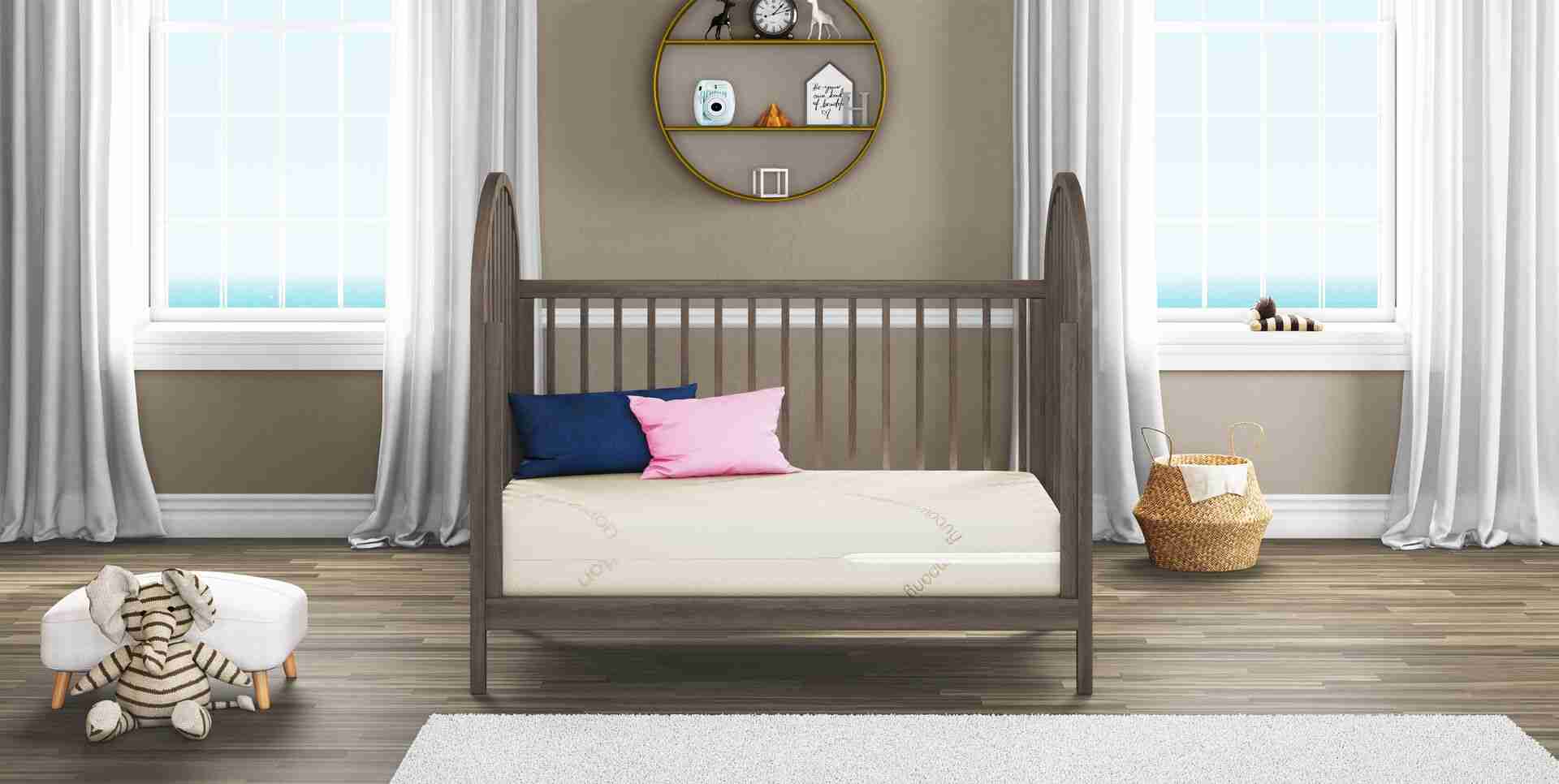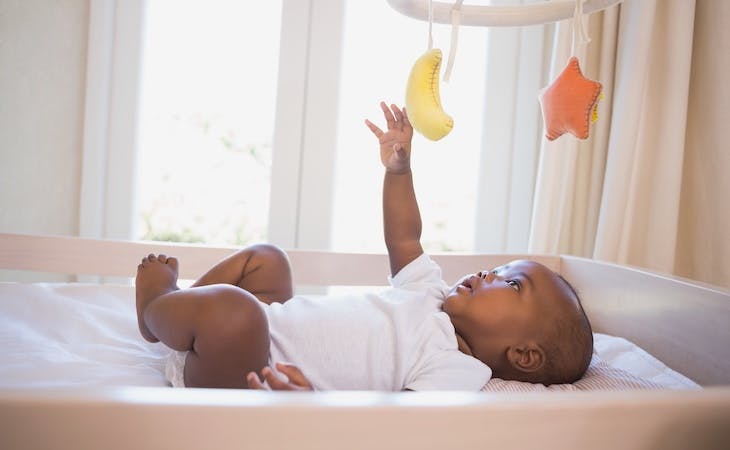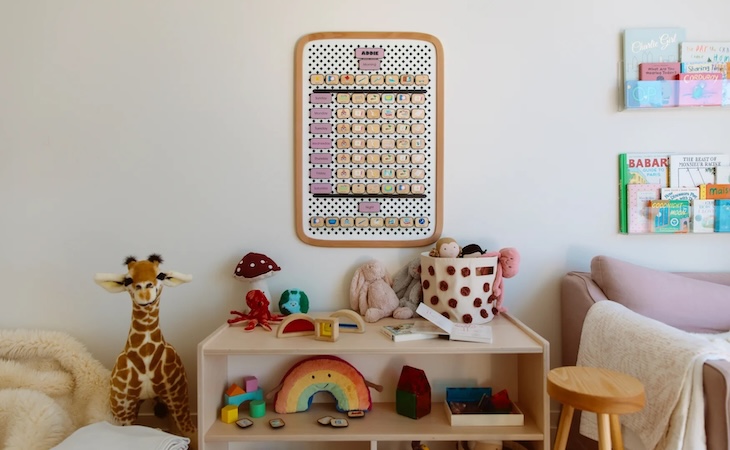Getting your baby to self-soothe and fall asleep on their own is a major sticking point for many parents.
Whether your baby relies on a bottle or breast to slumber or needs you to be in their constant line of vision until they snooze, you may have considered sleep training.
While sleep training can be a bit controversial, there are ways to make it work for you so it meets your needs and comfort level.
Learn more about how to sleep train a baby, according to experts.
Should you sleep train your baby?
Ultimately, sleep training is a personal choice and is meant to help parents and their babies get to a place where their babies can self-soothe and fall asleep on their own.
So even when they wake up in the middle of the night (and they will), they’re able to figure out how to transport to dreamland without having to be rocked or fed to sleep.
“If you’re exhausted because your child is waking all the time, or you’re exhausted because it takes forever to get your child to sleep, then you might want to consider gentle sleep training,” says Lynelle Schneeberg, PsyD, a behavioral sleep psychologist and author of Become Your Child’s Sleep Coach: The Bedtime Doctor’s 5-Step Guide, Ages 3-10.
You may be wondering how to sleep train your baby and what is the most effective and gentle way to do it. There are several sleep training methods (more on that below), but before you evaluate which approach is best for you, there are some factors to keep in mind, like how old your baby is and the timing of your sleep training.
“Don’t do it when they’re sick in any way, and don’t do it when any other big change is coming—for example, a new baby arrived, you moved, or you’ve just started a new job,” says Schneeberg. “Try to do it when things are calm and predictable.”
Related: Sleep Tips From the “Baby Sleep Boss”
Is sleep training safe?
Before you consider how to sleep train a baby, you want to ensure your baby has a safe sleep environment.
That means they’re alone, on their back, in their crib, bassinet, or pack ‘n play, and with caregivers who don’t smoke (these are the ABCDs), says Ashanti Woods, MD, a pediatrician at Mercy Medical Center in Baltimore. “By doing this, we are minimizing the risk of sudden infant death syndrome (SIDS),” he says.
If you start sleep training your baby when they’re developmentally ready and are gaining weight reliably and consistently, there’s no harm done in helping your baby learn how to fall asleep on their own, Schneeberg says.
Some parents might have concerns that sleep training can negatively impact the emotional bond they have with their babies, particularly because sleep training may involve letting your baby cry just a bit before you intervene. However, research shows sleep training doesn’t negatively affect emotional attachment in babies.
According to a small 2020 study in The Journal of Child Psychology and Psychiatry, following the “cry it out” sleep training method during the first six months wasn’t associated with adverse behavioral development and mother-infant attachment at 18 months.
In fact, research also shows sleep training leads to better infant sleep and maternal mental well-being. A 2007 study in the Archives of Disease in Childhood found that mothers who implemented sleep training at seven months improved their baby’s sleep and their mental health at 10 and 12 months. (Here’s what you need to know about RSV and sleep for babies.)
When to start sleep training
Experts have mixed feelings about when is the best time to start sleep training. Schneeberg suggests 6 months as a generally good time to do gentle sleep training if your baby is on track with their growth chart and is developing well.
“This is true for two reasons: Their sleep has consolidated into more recognizable sleep stages, [and] they start to have more recognizable patterns of dream sleep, deeper sleep, and lighter sleep,” she says. “They also have clearly separated naps during the day.”
Another reason why sleep training at 6 months is good is that “kids who are developing normally and healthily gaining weight don’t have any physiological need to eat at night anymore,” says Schneeberg, “but they might have what’s called a ‘learned’ need to eat at night, also known as a ‘feeding to sleep’ association.”
So sleep training can be beneficial for babies who have a learned habit of eating before bed because it helps them disassociate feeding as a means to falling asleep.
This means you would move their feeding earlier in the routine, so it isn’t the last thing you do before your baby is put to bed. Your routine would look something like this: feeding, diaper change, pajamas, a bedtime story, and some lullabies, and then bed.
However, Woods says you can start sleep training even earlier—as early as 2 to 4 months.
“It is at this time that most babies have a nice robust weight that will allow a child to fast for several hours in their sleep without it being detrimental to their nutrition,” he explains.
When in doubt, always check in with your baby’s pediatrician to see if sleep training is appropriate for their age.
Woods also suggests parents get their baby into a regular sleep routine at just two weeks old, which will help set them up for more structured sleep down the road.
“At 14 days, we have established that the baby’s weight is where we need it to be—usually gaining an ounce a day—and we have an idea of how much it takes to make the baby full if they are being bottle-fed,” he says. “This is a little trickier when they are being breastfed—however, we can estimate depending on how long the baby is at the breast.”
Related: How to Cope With Baby Sleep Regression
Sleep training methods
It can be overwhelming to choose a sleep training method, but the key is to do what works best for you and your child. Whatever method you choose, it’s important to remind yourself that you’re just helping your baby learn a really important skill.
“Your child protests a lot of things: being put in the car seat, not getting candy at the grocery store, and so on, but you don’t worry about this kind of protest because you know you are doing the best thing for them,” says Schneeberg. “Sleep training is like that. Your baby may protest a bit during sleep training, but you are teaching your baby such an important skill: knowing how to put themselves to sleep and put themselves back to sleep. And, really soon, everyone is sleeping so much better.”
And if you decide not to sleep train your baby, that’s also completely fine. There isn’t an official parent manual that tells you when and how to sleep train your baby.
“Just because a neighbor, family friend, or grandparent shares that a child was sleep trained at a certain age, it doesn’t mean your child has to be sleep trained at that age or at all,” Woods says. “However, we do feel that sleep training is a normal part of growth and development. We think that it will bring harmony to the entire family when a baby can safely and successfully put him or herself to sleep and stay asleep for a good period.”
If you’re interested in learning about what has worked for other parents, here’s a quick rundown of some of the most popular sleep training methods.
Cry it out
The cry-it-out method involves putting your baby in their crib while they’re drowsy but still awake and then leaving the room entirely.
Your baby will cry a bit in protest but will learn how to fall asleep on their own without you rocking, singing, or feeding them to sleep.
An important part of the cry-it-out method is to not take your baby out of the crib to soothe them if you go back into the room, according to the Cleveland Clinic.
“While some would say that your baby will learn more quickly if they are left in the crib, many parents can’t easily tolerate that, so I tend to recommend the ‘pick up, put down’ method, the ‘check and console’ method, or the ‘nearby chair’ method,” says Schneeberg. “These are all ways to stay nearby but still allow a child to learn to self-soothe with a little more hands-on time in the room.” (Learn whether weighted sleep sacks are safe for babies.)
Ferber method
Also known as the “check and console” method or “graduated extinction,” the Ferber approach was created by Richard Ferber, MD, a pediatric sleep expert.
You follow it by putting your baby to bed while still awake after a comforting sleep routine and leaving the room. Naturally, this will cause your baby to cry, but you go back into the room in intervals to check up on them and console them.
Say you hear your baby crying. You can wait to go into their nursery after three minutes, five minutes, 10 minutes, and so on. When you go back into the room, give your baby some reassurance, but avoid rocking them or feeding them.
“It’s OK to check on them every few minutes and say, ‘I’m here. It’s OK. It’s bedtime. I love you,’” says Schneeberg. “The Ferber method works as long as you don’t eventually feed or rock them—because if you feed them after a period of protest, you might train them to think, ‘if I cry long enough, I get the bottle.’”
Chair method
Schneeberg says many parents find success with the chair method because it’s one of the gentlest ways to sleep train.
With the chair method, you put your baby to sleep in their crib after concluding their bedtime routine, and then you sit in a chair next to their crib.
While sitting nearby, you can read, work, or do anything else to occupy yourself. This way, you’re not focused on your child figuring out the process.
Once your baby falls asleep, you leave the room. After a few nights, you’ll gradually move your chair away from your baby’s crib until you’re out the door.
“You sit in a chair and just read your book,” says Schneeberg. “You’re a calm presence, even though you might not feel calm.”
Schneeberg adds that your child will see you, but they’ll be in their crib, fussing a bit as they figure it out. “And then you can move your chair slowly, slowly out,” she says. “It’s probably the best default choice because the mother or father knows they are nearby but just not helping as much.”
Pick up, put down
This method allows you to literally take your baby out of the crib to comfort them when they’re fussing and then put them back down and leave the room. The key is to avoid cuddling them for too long; otherwise, it becomes another sleep crutch.
“The pick up, put down method is used to avoid your baby from getting to a 10, on a scale of one to 10, where 10 is very, very upset,” explains Schneeberg. “A parent would pick the baby up to soothe them when they are inching towards a 10. You pick them up, soothe them, and then you put them back down until they fall asleep on their own.”
Bedtime fading
Unlike other sleep training methods, bedtime fading is more about moving your baby’s bedtime to a later time.
The point of bedtime fading is to reduce the amount of time your baby takes to fall asleep at night, so it’s about paying attention to their sleepy cues.
For example, perhaps you’d like your baby to go to bed by 7 p.m., but they’re fussing and not going to bed. With bedtime fading, you would move their bedtime to 7:30 p.m., which makes them more tired and ready to snooze.
“Once your child can self-soothe to sleep, you’d move the bedtime up by 15 minutes or so every few nights until you are back to the 7 p.m. bedtime you wanted,” says Schneeberg. “You’re trying to increase your chances of success by putting them to bed a little later.”
Related: A Sleep Coach on How to Get Your Kids to Sleep
Sleep training tips
- Create a relaxing bedtime routine to help your baby ease into sleep. “When sleep training is initiated before two months, I like to empower my families to consider the four Bs then bed, which include bath, body rub (lotion, shea butter, or some emollient to seal in the moisture), book, and bottle or breast, then swaddle wrap and bed,” Woods says. However, you should stop swaddling when your baby can roll, which usually happens between two and four months.
- Put your baby into their crib at the end of the bedtime routine. “I always just say, put them into the crib at the end of a really cozy, comforting routine, where feeding is not the last step,” says Schneeberg. “Then, you can offer them any sort of comfort object that is safe for their age—a snuggly animal or a pacifier, whatever it might be. You just want them to fall asleep when they’re not being held by you.”
- Make sure your baby is fed regularly throughout the day. For their nighttime feed, Woods encourages parents to feed an extra half an ounce of milk to their regular amount. “This may mean that the family has to invest 15 or 20 more minutes to get the baby to take an extra 15 milliliters,” he says. “However, some babies will sleep an hour to 90 minutes longer with that extra volume of milk.”
- Stay calm. Sleep training can be frustrating and exhausting but try to remain patient and trust the process. “All babies will sleep eventually—it may not happen on our terms, but it will happen,” Woods says.
How long does sleep training take?
Sleep training generally takes 10 days for your baby to adjust to the new routine, but you need to be consistent with following the method you choose.
“Whenever you’re changing a behavior, you will want to stick with a method for at least a week because, during the first three nights, the child, if they could talk, might say something like, ‘What are you doing? I want to do it the old way!’” says Schneeberg. “So, you really need to keep going with the new method for about a week. Those first three nights can be the hardest and then you should see some positive changes.”
You might experience one more period of protest on about the seventh or eighth night too, adds Schneeberg, but after about 10 days, you’ll have real progress.
Related: Why Co-Sleeping Can Be Dangerous
FAQs
What is the best age to sleep train a baby?
Parents aren’t required to sleep train their baby, but if you’re considering it, you might find more success when your baby is around six months old.
At this stage, your baby has consolidated their sleep and doesn’t need to eat throughout the night to meet their nutritional needs.
However, some experts suggest that you can start sleep training as early as two to four months old. Babies at this age are generally on track with their weight gain and have established feedings. If you’re not sure, check in with your baby’s pediatrician. (See how much sleep your child needs by age.)
You can also help your baby adopt a relaxing sleep routine starting at two weeks old. For example, you can get them into a routine of taking a bath, getting a soothing massage, changing into pajamas, reading a book, and then feeding before going to sleep.
How long do you let your baby cry it out?
There aren’t set rules on how long you can let your baby cry it out; it’s normal for your baby to cry a bit in protest when you’re sleep training.
How long you can let your baby cry it out also depends on what sleep training method you’re following. If you’re following the Ferber method, for instance, you’ll check and console your baby in intervals, such as after three minutes, five minutes, and 10 minutes of crying.
On the other hand, the pick up, put down method calls for taking your baby out of the crib to help soothe them when they’re inching toward the brink of becoming extremely upset.
How do I sleep train my baby at night?
Sleep training is a personal choice; you don’t need to sleep train your baby if you’re not comfortable with it. But it can be helpful if your baby is having difficulty falling asleep on their own and it becomes detrimental to your and your family’s sleep.
Generally speaking, it’s ideal to start sleep training your baby when they’re about six months old because they’ve consolidated their sleep and no longer need nighttime feedings. But some experts suggest that sleep training can be introduced anytime between two to four months old.
There are many different ways to sleep train your baby, and the best method is the one that works for you and your family.
Some of the gentler sleep training methods are the chair method, pick up, put down, and the Ferber method. These methods help your baby learn how to self-soothe while allowing you to be a calming, comforting presence in some way.
Whichever method you choose, creating a relaxing bedtime ritual with your baby can help prepare them for sleep. For example, giving your baby a soothing bath, reading a story, and singing a lullaby or two before bed can prime them for slumber.
Choosing the right crib mattress for your baby
The right crib mattress can go a long way toward helping your baby get safe sleep. Check out our dual-sided

Our dual-sided crib mattress for little ones
, designed with the safety and unique sleep needs of babies and toddlers in mind.
Handcrafted with natural, nontoxic, eco-friendly materials, it gives you peace of mind as your baby is cradled in soothing comfort.




